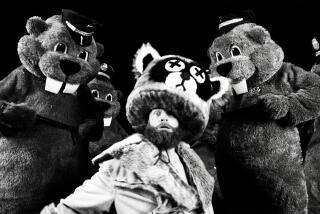Unnatural STAR POWER
The deathless film “The Natural” resurfaced yet again this summer, when naïve commentators from small towns to syndicated columnist Charles Krauthammer cited it while lauding Rick Ankiel’s magical rebound from failed St. Louis Cardinals pitcher to Herculean St. Louis outfielder.
As the latest incarnation of “The Natural,” Ankiel qualified as a one-man antidote to a season of cynicism until the New York Daily News reported Sept. 8 that he once received a shipment of human growth hormone from a suspect Florida pharmacy.
That seemed to quell any kinship to “The Natural,” yet a careful study of the 1984 movie with 2007 eyeballs reveals the comparison might just remain apt, for upon further review it’s all but certain that the Robert Redford character, Roy Hobbs, not only juiced, but juiced copiously.
This seems clear from the fanciful, sepia-toned get-go, when Hobbs’ father suddenly breaches a Midwestern game of catch to utter to the boy, “You got a gift, Roy. But it’s not enough. You gotta develop yourself. Rely too much on your own gift, and you’ll fail.”
The coy film never does acknowledge whether that directive prompted cheating, but it’s clear it might’ve planted a clue, for the hints shout thereafter.
For one thing, Roy Hobbs suddenly excels at the major league level at middle age, a sure-fire indicator of performance-enhancing drugs. He hits baseballs so far they shatter Chicago scoreboard clocks and New York light stanchions, and any but-it’s-hand-to-eye-coordination-apologist who tells you drugs can’t abet that kind of thing has “an IQ below room temperature,” Penn State epidemiologist Charles Yesalis said by phone. And then, as with many 21st-century juicers, the clueless people around Hobbs feel bafflement as to just how he does it.
There’s more. Shortly after Hobbs takes up a perfectly forgivable fling with the Kim Basinger character, he spirals into a slump, a telltale sign of departure from proper drug cycling. Defying medical advisability, he rapidly recovers late in the movie from a case of stomach-piercing food poisoning that threatened his participation in the movie’s closing game and thus the movie’s box-office potential. As he returns to the dugout from the hospital, Hobbs’ crusty but benign manager hollers, “Suit up!” which careful listeners might hear as, “Shoot up!”
Further, Hobbs benefits from a feckless commissioner -- same old story -- who ruled Hobbs’ controversial bat legit, probably to deflect attention from his mysterious bloodstream.
“How can somebody play that well, came from nowhere?” Max Mercy asked from the press box.
For once a sportswriter, even Robert Duvall’s fictitious one, graced the wise vanguard of skepticism.
Upon careful inspection, it’s even clear that the Glenn Close character in the film might’ve served as Hobbs’ supplier. There’s that code language when she invites him to her apartment and offers “coffee or tea.” Certainly her involvement in subterfuge would be counterintuitive given her sweet innocence, but we must remember that she turned up in a subsequent movie in a New York suburb, breaking into a family’s house and boiling its adorable pet rabbit on a stove.
Even before that and before her subsequent film appearance in an upstairs bathroom with a giant butcher knife, mystery surrounds her throughout “The Natural.” In the closing crescendo scene, she forces a note to Hobbs in the dugout, long believed to have something to do with announcing his son’s presence in the audience, but perhaps more realistic as a reminder he should ingest some amphetamines before that last at-bat.
Amphetamines would be the performance-enhancing drug most capable of forging a quick upgrade from painful strikeouts to a home run so mighty it short-circuited the stadium’s electricity, notes Dr. Yesalis. Humans first synthesized amphetamines in the 1870s, Dr. Yesalis said, but first comprehended their potential in the 1920s, whereupon they enhanced the college students and truck drivers of the 1930s, then the military sports teams and Japanese defense workers of World War II.
Suspicion of Hobbs, however, almost abates given a single reality. His unforgettable season came in 1939, according to the newspapers in the movie.
As Yesalis notes, there’s no evidence of any steroids in American sports that soon. The first athlete identified as a user would be Holloway, a harness racing gelding whose ruse turns up in an early-1940s veterinary journal.
But even to that doubt, the movie insists otherwise.
It simply refuses to address Hobbs’ 16-year absence after getting shot in the Chicago hotel.
Even in the scene in the Italian restaurant that strongly resembles the restaurant in “The Godfather” where Michael Corleone shot those two guys, Hobbs maddeningly refuses to supply the coach any details of the 16 years.
Where did he spend those 16 years?
“You might have had Roy making a trip to Berlin,” Yesalis said.
Oh?
It’s “historically accurate,” Yesalis said, that the first synthesizing of testosterone occurred in Europe, probably Germany, in the 1930s. It’s also a long-held rumor, never proved, that the Germans tried to deploy such advancements at the 1936 Berlin Olympics.
That may seem a stretch for Hobbs, yet it’s the best explanation to date for the secrecy of his demeanor, if not his kinship with Ankiel.
More to Read
Only good movies
Get the Indie Focus newsletter, Mark Olsen's weekly guide to the world of cinema.
You may occasionally receive promotional content from the Los Angeles Times.






